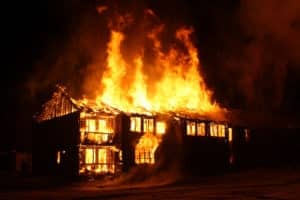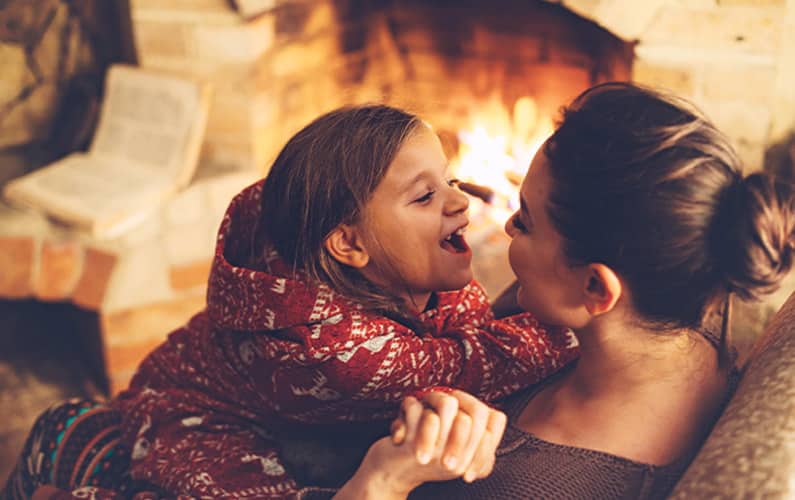February 2021 was a record-breaking cold season for the midwestern states. With sub-zero temperatures sustained for days and continued rolling blackouts across the country including our Kansas City area. Preparing for the unexpected and learning how to keep your chimney safe has never been more important.
Citizens nationwide have turned to their fireplaces or woodstoves to provide heat to keep homes warm. Thankfully our local Kansas and Missouri residents have been very fortunate when compared to the many people suffering in states like Texas.
Chimney and fireplace safety is something that must be addressed proactively. Annual chimney inspections are your #1 defense against hearth and household chimney fires. Your stove or fireplace must be ready BEFORE a power outage. BEFORE a natural disaster strikes, or another emergency arises where you would have no choice but to rely on burning wood to stay warm.
Winter Months Increase the Risk of Chimney Fires
The coldest months of the year lead to an increase in household chimney fires that can spread to the home. If you have a fireplace you may wonder how to keep your chimney safe, but not know where to start. We’re here to help teach you how to burn the fire you want… without starting one you don’t.
Here are few tips to help you keep your fireplace and chimney safe during the cold burning season.

How to Prevent Flue Fires
Here are 5 ways to keep a fire burning in your fireplace and avoid starting an unwanted flue fire that has the potential to spread and ravage a home.
Be proactive, don’t let it happen to you.
Tips on How to Avoid a Chimney Fire in Your Flue:
- Inspect and clean the chimney and fireplace system annually.
- If using a wood stove, install a stovepipe thermometer to monitor the flue temperature. Adjust as needed.
- Use only dry, seasoned wood.
- Making sure the wood is dry, is more important than the type of wood or whether it’s hard or softwood.
- Learn to build a better fire. Place firewood logs on a grate toward the back of the fireplace using one of the recommended methods.
Suggested Reading: Check out our helpful resource page to find out what kind of wood is good to burn.
The Best Time to Prepare Was Yesterday
There’s an old Chinese Proverb that says:
“The best time to plant a tree was 20 years ago, and the second-best time is now.”
– Unknown
When it comes to emergency preparations the same concept is true. The best time to prepare for an emergency was yesterday, but the next best time is today!
Even if you don’t burn wood very often it’s still a critical home maintenance task to keep a working fireplace and a clean chimney. One reason is to ensure you don’t accidentally burn the house down trying to stay warm when you need it. We don’t mean to sound insensitive, it’s just an unfortunate reality.
Our technicians work hard every day to help people understand the importance of chimney care and regular fireplace/stove maintenance.
Are you prepared?
Emergencies happen and there’s nothing we can do about that fact, except prepare. Your fireplace is no different and you must take action beforehand. Will you be ready to protect your homestead and its residents, aka the people that matter most in your life.
Ask yourself some serious questions:
- What would you do in the event of a cold-weather emergency?
- Do you have firewood ready to burn if needed?
- How long would your supply last?
- Would you be able to keep your family warm for more than a day?
These are important considerations for every responsible homeowner.
Don’t wait until it’s too late to prepare. Start now.
Alarming Fact...
Most homeowners have never heard the phrase: Gas Chimney.
Even if they have one in their homes!
Not knowing whether or not you have a gas chimney in your home poses a serious risk for the safety of your household.
Do you own any gas appliances, like water heaters or furnaces? If so, then you should also have them inspected annually along with your fireplace chimneys.
Find out more by visiting our Gas Chimney Service page.
Keep Your Household Safe
As fellow fireplace owners, we want to burn a nice fire but know that it’s critical to maintain a safe space for our family and pets.
You can protect your property and everyone living under your roof by simply educating yourself on a few fireplace safety factors.
Remember chimney fires are preventable and keeping your family safe is up to you.

Maintain Your Homes Hearth Safety
- A few other things to consider to keep the hearth area safe:
- Invest in a chimney cap to stop animals or other debris from entering the chimney.*
- Keep the room’s hearth area clear. **
- Glass doors can help keep kids from getting burned.***
- Using a fireplace screen can stop sparks from jumping out onto the carpet, rugs, or people standing too close. (Especially young children or babies).
- Never burn trash, recyclables, or debris in a fireplace!
- Install and keep working smoke alarms in the home.
- Install C.O. carbon monoxide detectors in the home.
- Don’t forget to keep fresh batteries on hand and change out the detectors regularly.
Notes:
Unless you heard a strange rustling sound, you may not realize an animal has entered your flue. Often fires start burning before homeowners realize something has entered through the chimney top. In which case that could be hazardous after a fire is already started. A chimney cap prevents this accident from happening.
Any combustible or flammable material should be kept at a safe 36-inch distance away from the fireplace.
Some fireplaces cannot have glass doors installed. Our Certified Chimney Sweeps can help you determine whether glass doors are suitable for your particular fireplace set-up at the time of inspection.
How to Keep the Rest of the House Safe When Burning
Our focus is on chimney and fireplace safety (because… that’s what we do here at Full Service Chimney), but there are other considerations that go beyond what we do. In the name of overall household fire prevention here’s a helpful video from FEMA regarding how to keep the rest of the homestead safe through the cold winter months:
Hopefully, these tips help to keep firefighters safe at the station, and out of your living room this burning season!
Article updated on February 18, 2021, with new additional content. The original post was written and created as part of a 2018 series for National Fire Prevention Week that happens every fall in the United States.
We continue to support Fire Prevention Week annually and will update and share our content regularly to help prevent household fires caused by chimneys or fireplaces.
#FirePreventionWeek
Learn more at:
Are you on social media?
Do your part to stay safe and keep your home and community safe too. Subscribe on YouTube and Follow us on social to share this content with people you care about.
You’d be surprised how many people don’t know about the importance of chimney safety!
Disclaimer:
Information provided is intended for educational purposes and is not a substitute for contacting the appropriate professional.
Call 911 in the event of a fire or other emergency.
Suggested Reading: What is Creosote Caution: Chimneys CAN Push Carbon Monoxide Inside

